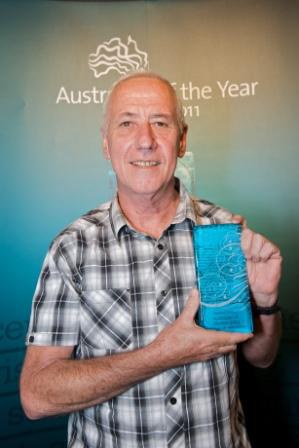By Professor MICHAEL CHRISTIE, 2011 Northern Territory Australian of the Year
WHEN I first arrived in Australia almost 40 years ago, I went straight into a Year 3 classroom of 45 aboriginal children on Milingimbi Island, Arnhem Land, none of whom spoke more than a few words of English.
At the end of my first year, the Whitlam Government introduced bilingual education, and Milingimbi was one of the first schools to start a program. Everyone was excited, the kids were encouraged to speak their own languages at school, the teaching assistants had the opportunity to do remote area professional teacher education through Batchelor College, the elders were welcome in the school, and aboriginal languages and all they entailed — ecological knowledge, ceremonial practices, singing, painting, dancing — were taken seriously in the curriculum.
There was also a policy move to allow people to leave the ex-missions and return to their ancestral lands to establish homeland centres. I soon was appointed as the school teacher-linguist and set up a Literature Production Centre, where we developed a series of graded readers for initial literacy, as well as hundreds of small books and magazines in Yolngu languages.
Within a few years we had gathered good hard evidence of the benefits of bilingual education for academic achievements.(Gale et al, Academic Achievement in the Milingimbi Bilingual Education Program, 1981)
Some years later I was appointed teacher linguist at Yirrkala School where the success of bilingual education had brought about what we came to call ‘aboriginalisation’ — not only of the staffing and curriculum content, but also of the pedagogy. The notion of ‘both ways’ pedagogy came to life as Yolngu began to institutionalise their theories and practices of knowledge production as respectful balanced collaborative performances engaging different knowledge traditions.
Both-ways education, with Yolngu teachers at the helm, began to reflect and reinforce more traditional approaches to the education of young people. The youngest children were allowed lots of outdoor and play experiences, and were encouraged to listen to the stories of their teachers, rather than to ask persistent questions.
More serious academic study was left until the students matured a little, and were confident in their own languages, clan identities and environment. Then we all know what happened. Moves from Canberra for national standardised testing in English, young students on remote communities — who have no need to speak English in their everyday lives — doing poorly on the tests, government embarrassment, the sudden announcement of four hours of compulsory English at the start of every school day, hidden and contested analysis of test results comparing bilingual and non-bilingual schools.
 Now there’s anecdotal evidence that school attendance in the ex-bilingual schools is worse than it has ever been. Meanwhile, the ever increasing dislocation of schools from their communities has resulted in massive unemployment and huge numbers of very short term non-aboriginal teachers, nurses, builders, plumbers and shire officials.
Now there’s anecdotal evidence that school attendance in the ex-bilingual schools is worse than it has ever been. Meanwhile, the ever increasing dislocation of schools from their communities has resulted in massive unemployment and huge numbers of very short term non-aboriginal teachers, nurses, builders, plumbers and shire officials.
The work that was done by community members 30 years ago — the building, nursing, teaching — is now done almost exclusively by outsiders. Meanwhile, in other contexts, aboriginal languages are alive and well — on the homelands, for example, despite radical disinvestment by governments. And the ceremonial life of Yolngu communities is still very active.
The program for teaching Yolngu languages and culture at Charles Darwin University has been going for well over 15 years with Yolngu lecturers and Yolngu supervisors teaching hundreds of students. Yolngu environmental knowledge of turtle ecology, for example, or fire ecology, plays a significant role in the work of university researchers.
Yolngu language teachers in Darwin and at remote homeland centres are using Skype to teach their languages to students in Japan and New York. Bilingual education was never really about the language of initial literacy. It was more to do with the role of aboriginal elders and their communities in the education of each new generation.
While there are always demonstrable cognitive benefits of bilingualism, the real benefit of bilingual education was the way it produced and ensured an ongoing collaborative relationship between the community — its family groups, its workplaces and environments, its connections to the wider world — and the staff and students in the school.


